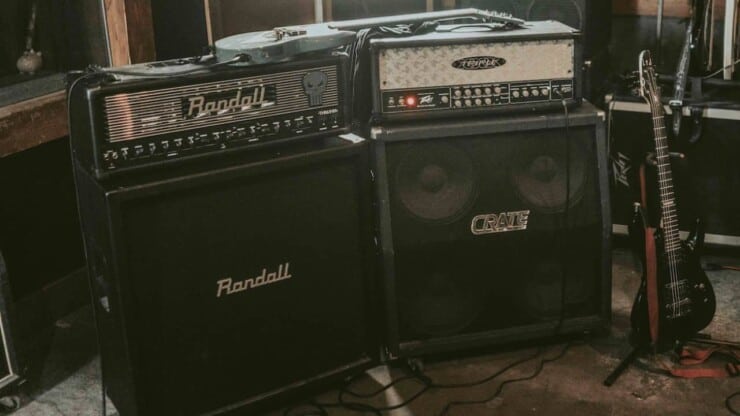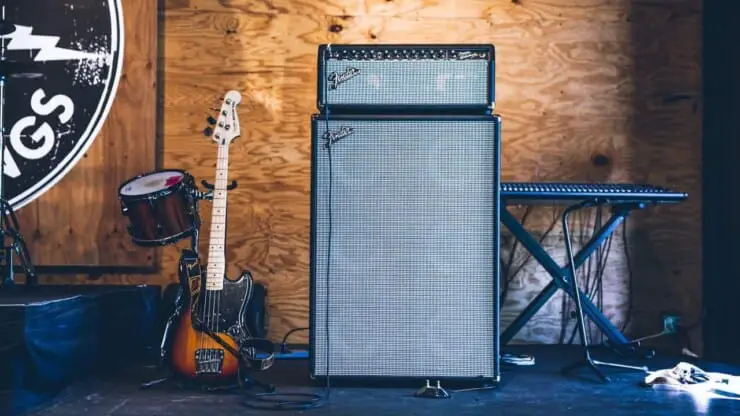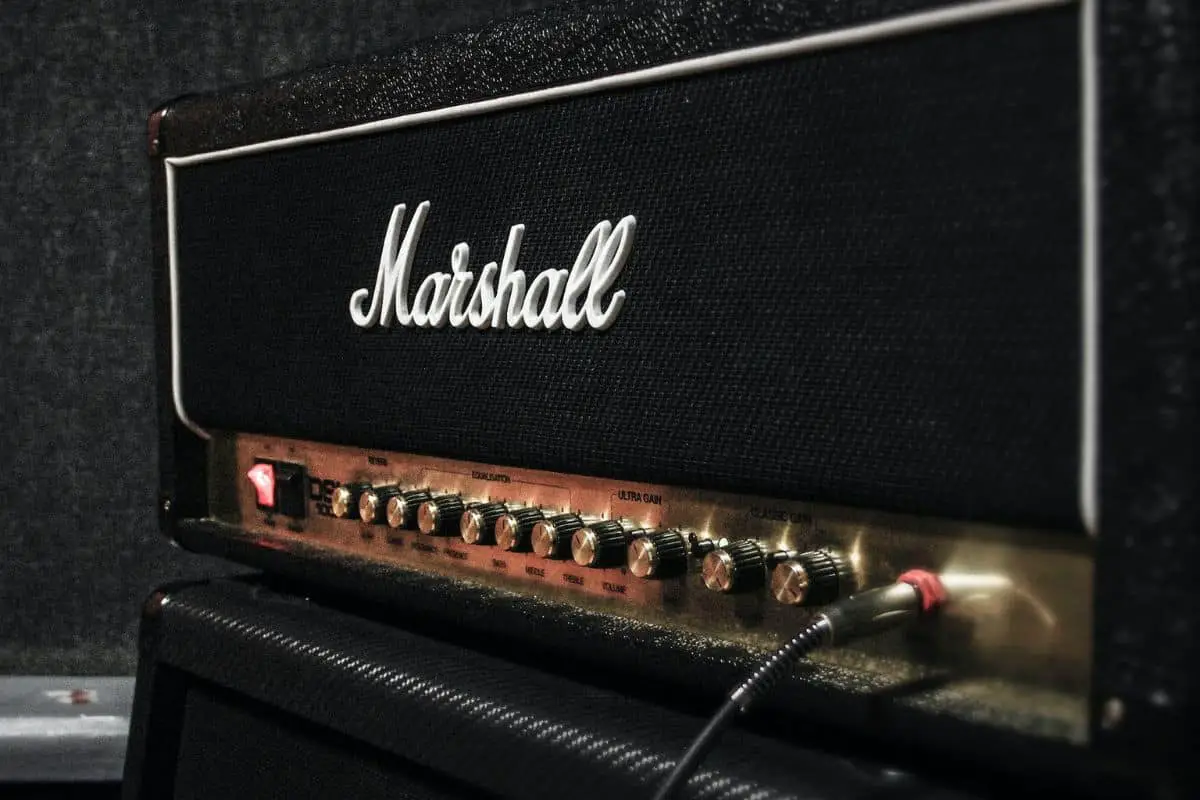Are you a beginner learning the guitar but struggling to come to terms with the concept of guitar amp heads? If so, then this article is just the right place for you to be.
A guitar amp head is a preamp and a power amp section without the speaker portion. It’ll process the signal and amplify it before going into a speaker cabinet.
In this article, you’ll get to learn all about guitar amp heads, what is a guitar amp head, how do guitar amp heads work, can you use a guitar amp head without a cabinet, and more. Stick around to know all the answers you’re looking for.
What is a guitar amp head?
When someone mentions the words’ amplifier, the first thing that automatically pops to mind is the standard combo guitar amp. But where exactly did the word “combo” come from, and what does it have to do with guitar amp heads? The combo amps come with the essential components combined into one device, hence the name combo. You have a power amp, a preamp, and a speaker all combined.
All that you need to do is plug in, turn the amp on, and rock! But there’s another type of amp that is incredibly popular, especially among experienced guitarists and professional performers. This formation involves a separate amp head and a passive cabinet.
A guitar amp head, essentially a power amp and preamp section, but without speakers. It’ll process the signal and amplify it before it goes into the speaker cabinet. You’ll be able to find the same formation with some home stereo systems with passive speakers and a separate amplifier. Similar to combo amplifiers, guitar amp heads can also be tube-driven or solid-state.
How do guitar amp heads work?
To put it simply, guitar amp heads work just like other amplifiers, only without speakers. As already mentioned, previously, a guitar amp head features a preamp section and a power amp section. The main tone-shaping process will happen in the preamp section. Almost all the knobs and controls that you’re seeing on the amp’s front panel are for the preamp section.
Most of the time, the preamps of amp heads and combo amps have at least two channels. These channels come with their own separate control for volume, sometimes separate equalization (lows, mids, and highs). Each channel will give you an entirely different tone, and they’re generally labeled as “clean” and “drive”. In certain cases, two channels may be identical, but they’ll allow you to create two different presets using individual controls. The preamps sections could also come with additional effects.
Meanwhile, the power amp section will do all the heavy lifting work. It’ll amplify the signal while giving it enough power before it goes into the speakers. It’ll also leave its mark on the overall tone, especially when you consider the tube-driven amp heads. Master volume and presence are integral parts of the power amp section.
Is it possible to use a guitar amp head without a cabinet?
The simple answer to that is a resounding no. You cannot use a guitar amp head if it isn’t accompanied by a cabinet. In fact, there’s a high chance that you might end up damaging your amp head if you’re turning it on without connecting it to a speaker cabinet. This is a no-go zone unless you feel like wasting all your money away. After all, you wouldn’t be able to get any sort of sound as a guitar amp head has no speakers.
There are the “dummy load” devices that’ll make your guitar amp head work safely without a cabinet. However, these are just for testing purposes. The point is that a guitar amp head needs to have some sort of load connected to it. Speaker cabinets and amp heads will come with a specified resistance. This is why you’ll have omega specified on any guitar amp head and a cabinet. It’ll be important to take care of impedance and to have amp heads and cabinets with matching omega. There are also different ways to connect multiple cabinets to a single amp head, but this is generally advanced territory.
Should you get a guitar amp head or a combo amp?
It’ll depend on what sound you really want to achieve. Combo amps are comparatively simpler and much more compact. More often than not, you’ll get two or more speakers in a combo guitar amp. There are even many guitar amp models available as an amp and as amp head and combo versions. These include Marshall DS120HR 20W amp head and Marshall DSL 20CR 20W combo amp.
Combo amps are usually a much more practical solution. You will just need to take everything with you in one device. Although they’re usually associated with cheaper amps for beginners, there are many high-end combo amps with amazing tones and features.
Overall, combo amps are far more widespread. Even though a guitar amp head and a cabinet formation may be a bit too bulky, it’ll open up a few different possibilities. First, you’ll be able to combine any type of amp head with any type of cabinet. In that sense, it’ll be far more customizable. You’ll just need to find the best speaker and amp combo that you believe will suit your needs. Additionally, different construction and cabinet materials will also greatly impact the tone.
In certain cases, guitarists prefer to remove the back cover of the cabinet, which tends to change the overall tone. Taking both the amp head and a separate cabinet to live gigs and rehearsals could be difficult. However, if you’re just going to the rehearsal space or a club with their own equipment, you can just take the amp head and then attach it to a suitable cabinet. Essentially, combo amps will be simpler to use while guitar amp heads and cabinets will offer more versatility.

Advantages and disadvantages of separate head and cab vs combo amps
Combo amps will offer the added benefit that they’re easy to set up. This is the case as they’re just a single unit. There is no separate speaker cabinet to connect and set up. You can simply plug in the guitar, turn on the amp, and start playing. For this reason, beginners tend to be attracted toward combos as their first guitar amps.
A combo amp will also be generally cheaper than buying the equivalent separate head and cabinet amp. Although, you should consider that if in the future you’re looking to upgrade the amp, if you’re using a combo, you’ll need to purchase a whole new combo unit. On the other hand, if you’re having a head and cab, you’ll need to just buy a new head and then run it through the existing cab that you’re already owning.
The last point is a great pointer towards a massive advantage of the head and cab setup – its versatility. With a combo amp, you’ll be stuck with using the built-in speaker. Meanwhile, you’ll be able to try your amp head with a wide variety of different cabs until you can find one that you can work well with. Interestingly, there are hacks to actually change the speaker of your combo amp.
Although, you need to know what you’re doing with the soldering iron. You can even add an extension cabinet to some combos. But if you still have to read articles about “what is a guitar amp head”, then it’s highly unlikely that you’re at a stage where you can perform such work on your combo amps.
If you’re thinking of purchasing your first amp, are you looking for just a practice amp? If you’re not involved in any gigging yet, this could be all that you need for now. If so, the vast majority of practice amps will be in the combo format. In practice, it doesn’t matter a lot which format you choose, both of these setups will give you tremendous sound.
Are tube amps only sold in “head” form?
No, not at all. You can always buy both tube heads and tube combo amps. The same will be true for other types of amps – digital modeling amps and solid-state amps will also come in both head and combo formats. There is this misconception, and it comes from the fact that many professional guitarists play tube amps. They’re also most likely to play through separate head and cabs, so it’ll be easy to see how this mistaken correlation can be made. Ultimately, you’ll have the freedom to buy all the different types of amps in both head and combo formats.
Guitar amp features to consider when buying a new amp
When you’re in the market pondering over whether to buy a combo amp or a head and cabinet amp, there are certain features to consider. Here are some of the features to keep in mind when buying a new amp.
Watts of the guitar amp
The volume of the guitar amp will depend on its wattage. You could go as quiet and affordable as the Vox Amplug, which is a sub-1W unit that plugs into headphones. For personal bedroom practices and jam sessions, guitar amps between 15W and 40W will give more than enough power. For larger venues, live shows, and noisy rock rehearsals, 50W-100W amps will be loud enough to cut through guitars, bass, and drums.
Vintage or modern sound
The amps that have defined the classic rock sounds of the 60s used vacuum tubes. They were able to produce a warm, vintage-style tone. Venerable brands from that era were Fender, Vox, and Marshall, and they still make tube amps with the specific sounds.

Fender tube amps are known for having clean surf and country tones. However, guitarists prefer using Vox for the jangly, mid-heavy sounds of the Beatles. For Marshall amps, they produced the massive crunch for the 70s supergroups like Led Zeppelin. The drawbacks of tube maps are probably their price and the fact that they lack versatility.
Amps that make use of solid-state transistors are a much more approachable alternative to tube amps. They need less maintenance and are lighter and much more affordable. Smaller solid-state maps by Blackstar and Fender are amazing for home practice. Moreover, they can easily adapt to effect pedals better than many tube amps. One of the most versatile options includes digital amps such as the Fender Mustang GT. It comes with preset sounds capable of emulating multiple effects and specific vintage tube amps. However, many purists believe that digital modeling amps tend to lack the warm authenticity of analog effects pedals and tubes.
Channel surfing
Multichannel amps are a great option for guitarists who use plenty of different tones. If you’re looking for a good, clean sound and a distorted sound, they might be more amp than you need. If you decide that an amp with 3 or more channels is right for you, you should look for one that offers separate EQ controls for each channel.
Twist the knobs
You need to be able to dial in a sound that you’d like quickly and easily. Adjust the tone control and note how they’re interacting with each other. If it is too hard to dial in a decent tone, chances are that you won’t be able to when you’re getting the amp home or onstage.
Speakers of the amp
Although technically, they’re not a part of an amp, speakers still play a massive part in the sound that is produced. Most amps are actually combo amps, housing one or more speakers between 6” and 12” in diameter in the same enclosure as the amplifier. Combo amps could be small, at-home practice amps, or large, suitcase-sized 100W models.
Some guitarists prefer the versatility of separate guitar amp heads such as the Fender Bassman and the EVH 5150 designed by Eddie Van Halen. Heads don’t contain speakers, but they can be connected to external speaker cabinets. They can easily house between 4-8 separate speakers, usually between 10” and 15” in diameter.
Although speakers are often overlooked, the speakers are one of the amp’s most crucial components. They’re the last thing that is standing between all the electronic gobbledygook and the sound that’ll reach your ears. Different sized speakers will have different tonal characteristics, and you’ll need to consider speaker sizes like how you’d consider the amp’s wattage rating.
Tube, solid-state, or digital
Although tube technology is still considered to be state-of-the-art in countries where potatoes are regarded as a square meal, the modern solid-state and digital amps offer amazing tone for a lot cheaper price. Moreover, there are fewer maintenance headaches involved as well. However, tube tone is still considered to be the standard by many top guitarists. To determine what’s best for you, take a blind listening test and let your ears decide.
Size of the amp
A 100W stack will be overkill if you’re playing in an apartment and only need the amp for home recording. A 10W combo, on the other hand, will be woefully inadequate if you’re playing in a band with drummers and bass players. Choose the right amp that is right for your needs. You’ll need at least 30W for playing a live gig, but smaller amps could offer surprisingly amazing sounds in the studio. As a rule of thumb, if you’re playing often, you could shoot for at least 15W of tube tone.
Sound of power
Distortion is often generated by three distinct sources – the preamp, the power amp, and the speakers. Many players tend to overlook the power amp distortion when looking for an amp. However, the power amp section is the source of what professionals describe as low-end chunks and balls. You can audition the power amp by turning the master volume all the way up and then turning down the gain. The sound will be likely sweet and be accompanied by a crisp attack that jiggles and moves you.
A righteous buzz
Preamp or gain controls (often called “volume” on master volume-equipped amplifiers) will allow you to dial in impressive-sounding distortion at low volumes. However, excessive preamp distortion could sound excessively compressed and sizzling at high volumes. You should turn down the gain while cranking up the master volume until the amplifier is set at the output level that you normally play at. Then, slowly increase the gain until the sound has become as distorted as you want it to be.
Crunch
Overdriven speakers will create one of the most desirable distortion characteristics – crunch. The best way of testing for this would be to dial in a clean setting and then turn the volume all the way up. Low-wattage speakers could break up at lower volumes, but they’ll have a tendency to turn to mush at excessive volume levels. High-wattage speakers, on the other hand, might not break up at all. You should choose a speaker that sounds extremely lively, defined, and harmonically rich at volume and distortion levels that you’ll normally play at.
Other feature
While volume and tone should be your foremost considerations, you must be able to determine the extra features you need. Built-in effects will be great if you’re looking for a no-hassle, all-in-one package, but they might not be as flexible as effects pedals and processors. An effect loop will be useful for effects like delay and reverb. However, it isn’t essential if your effects consist of some stomp boxes. Line outputs with speaker emulation help in home recording, and external speaker outputs are great to expand your live rig.
Which amp option to go for?
The best amp will depend on where you’re looking to take your guitar act. Beginners, especially younger guitarists with noise-sensitive parents, can start with an affordable headphone unit. Small modeling combo amplifiers will be a great option as they’ll come with several effects and tones for guitarists searching for their sound. Established players will likely know what their detailed amp preferences are. If you’ve decided that there isn’t a substitute for loud, classic goodness, there will be no replacement for splurging on premium tube combo or head and cabinet amps.
Conclusion
Thank you for reading. Hopefully, now you know a lot more about guitar amp heads, what is a guitar amp head, how do guitar amp heads work, can you use a guitar amp head without a cabinet, and more. A guitar amp head is essentially a preamp and a power amp section, but without a speaker. It’ll process the signals while amplifying them before going into the speaker cabinet. You will find the same amp head formation with home stereo systems with passive speakers and a separate amp. Similar to combo amps, guitar amp heads can also be solid-state or tube-driven.



